The medial collateral ligament or MCL is one of the major ligaments that support the knee and it connects the femur (thigh bone) to the (tibia) shin bone while running on the inside of the knee. MCL injuries are caused by valgus force i.e. a force that causes the ankle and foot to move laterally. Because of such force, the medial side of the knee is opened and the structure on that side of the knee is injured as a result. During contact sports like football, a blow to the outside of the knee while the foot is planted may cause such injuries.
Healing process from these injuries often involves wearing knee braces which prevent valgus stress on the knee. The brace has hinges to allow full flexion and extension but prevent side-to-side motion. To perform aggressive physical activity during the treatment of MCL injuries, the orthopedic surgeons recommend functional braces and knee sleeves or over the counter braces may not be adequate for this purpose.
While wearing the knee brace, the injured athlete can be engaged in non-impact activities such as cycling, elliptical training, and swimming early in the healing process. These exercises are less stressful to the injured knee and strengthen knee muscles which in turn accelerate the healing process. Also, knee braces reduce strain on your knee ligaments (MCL, ACL, PCL, and LCL) by applying pressure on your leg at different points.
Grades of MCL Sprains
The medial collateral ligament can be injured in various fashion. Trauma on one side of the knee will injure ligaments on the other sides of the knee when the trauma pushes the bones of the knee with enough force to tear or stretch the MCL. The physical activities which involve twisting, bending or quick change in direction of the leg are most likely to cause MCL sprain and tear. Depending on the extent of the damage, the MCL injury can be classified into three categories:
- Grade 1: The mildest injuries of MCL fall under this category. Usually, there is no swelling involved and only just minimal pain is involved in such cases. It may take 1 to 3 weeks to heal and rarely need knee braces.
- Grade 2: There will be limping, pronounced tenderness is felt along with the MCL and inside the knee, swelling, and sharp pain while running and climbing the stairs. Light bracing is beneficial in Grade 2 MCL injuries. In 2 to 4 weeks, it will heal completely.
- Grade 3: The complete tear of MCL is expected in such injuries. It will feel like the knee is giving away during stairs or walking. Limping is usual in such injuries and surgery is required when the ligament is torn in such a way that it can’t repair itself. The grade 3 injuries are the most severe and require the longest recovery time, eight weeks, or more.
Best Knee Brace for MCL Tear
1. DonJoy Drytex Hinged Air Knee Brace
This hinged knee brace utilized hypoallergenic, ultra-breathable Drytex which is an alternative to neoprene. It is called “Air Knee Brace” because it features an inflatable pneumatic buttress for medial, lateral, or full patellar support. Signature polycentric hinges from DonJoy offer medial/lateral support and flexion/extension control and the flexon stop can be adjusted for 45, 60, 75, and 90-degrees. The brace can be worn on either the left or right knee.
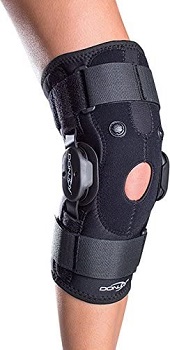

DonJoy Drytex hinged air knee brace is designed for the conditions like medial/lateral instabilities associated with patellar tendonitis, chondromalacia, patellofemoral malalignment, MCL or LCL sprains, and post-operative meniscectomies. To fit properly, the brace is fashioned with adjustable straps.
- Inflatable pneumatic buttress for patellar support
- Non allergic material
- Excellent air circulation
- Polycentric hinge to provide strong structural support
- Flexion stops with varying angle
- Universal design
- To find the right size from the size chart can be difficult sometimes
2. DonJoy Performance Bionic Knee Brace
It is rather important that the knee brace fits perfectly over the knee joint of the patient to function properly. DoJoy Performance Bionic knee brace features asymmetrical hemlines along with top and bottom stretch webbing closure systems for a precision fit. Because of wrap-around design, this brace can be worn very easily with the shoes on. This design also increases comfort and encourages the user to wear it more often as the brace can be put on and off effortlessly.
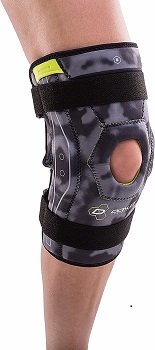

During intense physical activities, the brace will stay in place because of anti-migration technology. Bilateral polycentric hinges with hyperextension stops provide adequate support for unstable, damaged ligament and sprained knees. The reflective coating of the brace offers visibility in low light. There is a stash pocket on the upper side of the brace for cards and keys.
- Hinged knee brace with ample support for unstable knee joint
- Anti migration technology to prevent slipping off the knee
- Universal design for left or right knee
- A stash pocket for small valuable items
- Good visibility due to reflectivity
- Easy to wear wrap-around design
- Extravagant
3. McDavid 429X Knee Brace
McDavid knee brace features geared bilateral polycentric side hinges for improved support along with knee stability and helps to recover knee injury. This brace adopts heavy-duty design and tough build. It is made of 100% latex-free 4.8 mm neoprene. The perforated back panel of the brace enhances comfort by reducing humidity and temperature significantly. For the customized snug-fitting, there are elastic crosses fitting straps at the top and bottom of the brace. These straps improve rotational and collateral ligament support.
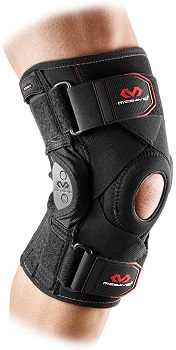

The brace provides compression as well as heat which keeps the muscles warm and increases blood circulation. McDavid 429X knee brace has padded opening on the patella side and 360° padded buttress isolates and supports the patella. The bound edges are comfortable and prevent skin irritation.
- Latex-free material
- Perforated back panel for moisture and thermal management
- Open patella design and padded buttress for patella support
- Affordable
- Geared hinges for maximum support
- Determining the right size from the size chart can be tricky
4. DonJoy Performance Bionic Drytex Hinged Knee Sleeve
Although it’s a knee brace, the DonJoy knee sleeve incorporates hinges for additional structural support. This sleeve is constructed with patented Drytex material, an alternative to neoprene. This material wicks away moisture and allows good ventilation. To protect and support the knee cap, this sleeve adopts an open patella design. For added comfort and prevent sliding off position, the hinge cover of the brace has cushioning and hemlines are made of silicone. Also, the meshed back panel improves the breathability of the brace.


The top and the bottom quick straps secure the brace over the knee joint conveniently and help to adjust the fitting. The brace will fit right or left knee and it has excellent visibility in the poorly lit condition. Bilateral polycentric hinges provide ligament stability and protection. The sleeve is easy to wear and fits tightly.
- Sleeve design makes it easy to wear
- Open patella design to protect the patella
- Hypoallergenic and breathable material
- Reflective knee brace
- Hinged knee sleeve for structural support and controlled range of motion
- The brace can bruise on the thighs
5. Shock Doctor Bionic Knee Brace with Compression Sleeve
Shock Doctor Bionic Knee brace is lightweight knee brace that incorporates cutting edge technology and engineering. The semi-rigid structure of the brace permits self- adaptive Flex-Fit for the comfort of a custom made brace. The sleeve-lock fit system compression sleeve of the brace provides enough compression force to support and protect the knee joint and wraps around to keep the knee warm. This brace is designed following the Bio-Logix philosophy which is an approach completely focused on natural human form and limits. It is anatomically designed for both men and women.
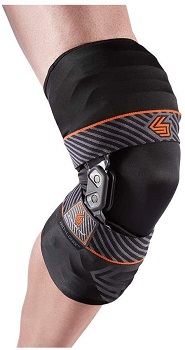

Shock doctor Bionic Knee brace strategically incorporates rigid and soft materials to create a comfortable supporting structure. The bilateral aluminum hinges on both sides of the knee joint provide level 3 support and they don’t interrupt the natural range of motion. The washable Flex-Fit lining pads on the shin and thigh are moisture-wicking and breathable for avoiding irritation and discomfort while wearing the brace. The strapping system allows a wide range of adjustment
- Maximum structural support provided by the dual bilateral aluminum hinges
- Highly engineered brace
- The unique supporting structure which combines both soft and brittle materials
- Adjustable strapping system
- Washable lining
- Comes with knee sleeve for 4 way stretch compression support
- Bulky construction
6. DonJoy Reaction Web Knee Support Brace with Compression Undersleeve
This knee brace features an innovative open webbing framework which is coupled with a meshed back panel. This design helps to absorb shock, disperse energy, and shift pain away from the injured knee. Large openings of the web design reduce the weight of the device, improves ventilation and comfort. The webbed front-side dynamically stabilizes the patella (kneecap) on all sides, bringing the patella into a proper tracking position to reduce pain.
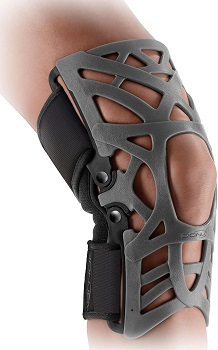

DonJoy Reaction Web Knee Support Brace was developed by an orthopedic surgeon. The elasticity of the reaction webbing and flexible hinges work together to stabilize the knee by absorbing shock and relocating weight from the affected area. This brace is recommended for conditions such as chondromalacia patella (runner’s knee), patellofemoral pain syndrome (PFPS), patellar tendonitis/tendinosis (jumper’s knee), general patellar tracking issues and instability, Osgood-Schlatter disease, and mild knee osteoarthritis.
- Works for varieties of medical conditions
- Excellent breathability and comfort
- Lightweight
- Economical price
- Designed by the orthopedic surgeon
- The hinge may get rusty
7. Shock Doctor 870 Knee Brace
Shock Doctor 870 is a knee stabilizer incorporating pre-curved anatomically designed conical straps for consistent compression and comfortable fit. For additional support, large stays that run along the length of the knee joint are employed. This knee stabilizer is advised for minor to moderate sprains, strains, and instabilities, joint pain, arthritis pain relief, arthritis symptoms, etc. during active recovery.
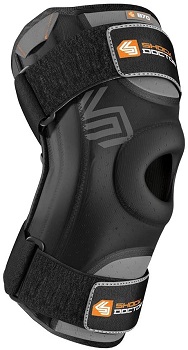

The knee brace provides therapeutic warmth along with compression to assist healing. It is made of vented neoprene for airflow which wicks away moisture and four-way stretch lycra mesh at the back of the knee makes brace rather comfortable for prolonged use. To protect and stabilize knee cap, Shock Doctor 870 knee stabilizer is fashioned with padded patella buttress.
- Breathable and moisture-wicking material
- Lycra mesh back panel
- Integrated side stabilizers
- Anatomically designed
- Latex-free
- Affordable
- At first, figuring out how the straps work for the brace and put it on or off.
8. EXOUS BODY GEAR Knee Brace
Designed to perform for a diverse age range of both men and women, Exodus Bodygear knee Brace EX-701 is ideal for athletic and gym activities. Patent-pending 4-way strap system wraps the knee from every angle and gives sturdier support than 2-strap or 3-strap. It also provides non-slip fit during physical activities and the device fits on both the left or right knee. There is a gap behind the knee to facilitate a breathable area to prevent irritation and sweating. This allows the user to bend as low as possible.
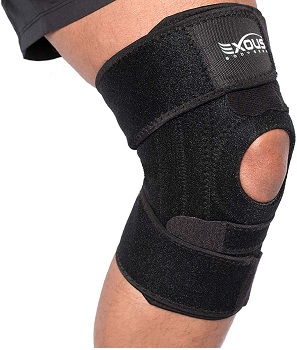

Along with a 4 point strap system, the EX-701 knee brace also has side stabilizers. Two flexible coil springs are used as a stabilizer to stabilize the knee on the medial and lateral ligaments. This knee stabilizer utilizes comfortable jacquard lycra mesh for avoiding skin irritation. To help with the jumper’s knee symptoms and inflammation, two dedicated crossover straps are positioned above and below the patella.
- Unique 4-way strapping system
- Additional knee stabilizers
- Dedicated patella support
- Skin-friendly material
- The gap behind the knee increase comfort and air circulation
- Affordable
- Straps loose adhesive qualities after washing
9. BIOSKIN Gladiator Knee Brace
Bioskin Gladiator Knee Brace helps to recover the medical conditions like Lateral Collateral Ligament (LCL) tear or sprain, anterior Cruciate Ligament (ACL) Sprain, medial Collateral Ligament (MCL) tear or sprain, posterior cruciate ligament (PCL) sprain, and knee Instability. Bioskin features 100% latex-free and neoprene free hypoallergenic material which is breathable, thin, and tough.
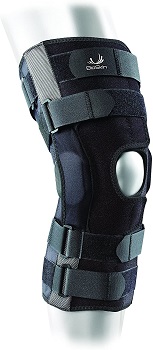

The brace includes a 15-inch range of motion hinge and firm strapping system to minimize painful movements and protect damaged ligaments. The wrap-around design of the brace allows the user to wear the brace from the front side. For patella support, Bioskin Gladiator knee brace features Visco gel rings on the patella region. The Bioskin brand is endorsed by more than 40 professional teams.
- Hinged knee brace for solid knee support
- Comfortable patella support to protect knee cap
- Easy to wear strapping system
- Non allergic material
- Good air circulation
- Bulky construction
Consideration Before Buying Knee Brace for MCL
A knee brace is quite beneficial in MCL injuries by providing structural support. Before purchasing a suitable knee brace, some key factors should be examined thoroughly.
Comfort
The patient has to wear the knee brace over a long period and hence, the brace has to be comfortable to wear. If the user feels itchy or sweaty, it will be difficult to use the device. The brace should be made of non-allergic, breathable, and moisture-wicking material.
Size
Since the knee joint size is unique for an individual person, it is difficult sometimes to find a snug-fitting knee brace. Some knee braces have adjustable fasteners to fit the device properly. Proper fitting is vital for a knee brace to function properly. If the brace is too tight, it will obstruct the blood circulation and if it’s loosely fitted, it won’t be able to provide compression support.
Brace Type
Some common varieties of knee braces would be hinged, knee sleeve, support, and knee stabilizer. These braces are designed to serve specific purposes. For example, the knee sleeve compresses the knee joint and provides minimal structural support. This sleeve is worn during weight lifting or other forms of physical exercise to protect and support the knee.
The knee stabilizers have built-in metal springs on both sides of the knee which offer moderate structural support and the device wrapped around the knee joint to compress it.
The hinged knee braces are designed to provide maximum structural support and they restrict the natural movement of the knee joint to heal the severe injuries. Hence, you have to have a clear understanding of your requirements and the conditions of your knees to choose the right knee brace.
Stability
The knee joint has to be stable in order to recover the injured parts of the knee. The level of stability offered by a knee brace depends on how rigid the device is. For minor injuries, the brace doesn’t have to be very stiff and hinged braces are not necessary.
Ease of Use
If it takes a considerable amount of effort to wear the brace, it will discourage you to wear the brace often. So, the knee brace has to be easy to put on and off. Machine washable knee brace offers extra convenience when it comes to clean the brace after several usages.
Treatment for MCL Injury
Depending on the nature of injuries, the treatment options vary. The injury is diagnosed using an MRI scan which locates a tear in MCL and examining the symptoms. If a broken bone in or around the knee is suspected, the doctor asks for an X-ray. The good news is, MCL injuries hardly require surgeries and completely heal on their own. However, in order to accelerate the healing process and relieve the pain, different types of medical treatments are recommended based on the condition and severity of the injury.
Immediate treatments are required to stabilize the knee and reduce the pain. Applying ice to the injured area will reduce swelling. The knee should be elevated above the heart to reduce the swelling further. Nonsteroidal anti-inflammatory drugs help to lessen pain and swelling. Proper rest and using crutches to unload the knee will be beneficial, too. The knee joint should be compressed with elastic bandages or knee brace.
Rehab programs help to regain strength in your knee and prevent further injury. Physical therapy is employed to strengthen muscles and improve your knee’s range of motion. A protective knee brace is required during physical activities to protect the knee joint from repeated injuries. Physicians will suggest refraining from activities like contact sports which can cause the injury again.
Surgery is rarely required for MCL injuries. When MCL ligament is torn in such a way that it’s not possible to recover itself, corrective surgery is a practical option for such cases. The arthroscopic exam is performed thoroughly to examine the extent of the injury and to look for associated injuries inside the knee. To reattach the torn ligament to either the shinbone or the thigh bone, methods like large stitches, bone staples, metal screws, or a suture anchor may be adopted. If the ligament is torn in the midway, it is stitched together.
Exercises for MCL Tear
A physiotherapist will be able to recommend strengthening exercise to help the recovery process after MCL tear. Strong quadriceps muscles will absorb some impact force to protect medial collateral ligament during activities like running, jumping, and climbing stairs. Hamstrings work in coordination with the quadriceps muscles stabilize the joint while performing physical exercise. Strong hamstrings also reinforce the hip and strong hip, in turn, prevents the knee joint from “caving in” when doing high-stress knee bending exercises. Also, mobile knee joints won’t get stiff and physical activities to keep MCL strong and flexible.
In order to boost the strength hamstrings and quadriceps muscles, some strengthening exercises are
Hamstring curl: to perform this exercise, first stand up straight with your feet hip-width apart. Then shift weight onto one leg and slowly bend the opposite knee bringing the heel toward the hip. After that, lower your foot slowly. You have to complete 12 to 15 reps for one leg and then do the same with your other leg.
Wall slide: first, you have to stand against a wall placing the back firmly and put your feet flat on the ground. Then, slowly slide down rubbing your back against the wall. After reaching a squat position, hold for 30 seconds. Then, push up using feet to stand up while rubbing the back against the wall. Perform 10 to 15 reps.
Chair squat: while standing on one leg in front of a chair, slowly squat towards sitting position onto the chair. Then, return to a standing position again using one leg. When standing, maintain the body in a straight line and bend at the waist.
These are some common resistant exercises targeted to strengthen hamstrings and quadriceps muscles. There are different levels of these exercises along with other variations. You should consult medical practitioners for the best advice.
Finally, it can be concluded that knee brace is quite safe to try in the MCL tear and related injuries. But to get maximum benefit, proper devices have to be selected.
